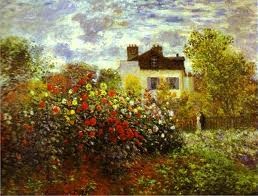郑板桥爱竹,徐悲鸿爱马,而与莫奈一生相伴的则是睡莲。这位法国印象大师被誉为“光的诗人”,一生都执着于表现光影变化的描绘。其代表作睡莲系列,以丰富而高雅的色调和极具灵动的笔触,生动地描绘出睡莲在不同时段的迷人光影。而这一切都源自他自己设计修建的莲花池。
英式发音 适合精读
1)Giverny has become one of the most famous gardens in Europe, if not the world. And it's visited by up to half a million people in the seven months of the year that it's open. Monet was obsessed with his garden and painted it continuously for 40 years until his death in 1926. It is the 2)archetype of the creative relationship between painting and gardening, and every aspect of the garden is driven by colour and light.
吉维尼即使不是世界上最有名的花园之一,在欧洲也是数一数二的。它每年开放七个月,年访客量多达50万人。莫奈对这个花园很着迷,直至1926年逝世,他连续花了40年在这里写生作画。绘画和园艺能够互相激发创意,这个是典型例子。这个花园的每一处都与色彩和光线息息相关。
 It appears like there's a sort of pair of 3)borders, huge borders, going up either side of this path. In fact they're made up of a succession of small raised beds, each one with its own mini-theme, each mounded up, in a slightly chaotic, but almost 4)arbitrary pattern, but then you start to notice that the colours are working together. Now it's been said that these are like an artist's 5)palette in the way they're laid out. But it seems more to me like the way that a picture is built up, a painting. The overall effect has a sort of general theme, but then individually you start to look at the way it's put together and a whole series of little mini-events happening to make the bigger picture.
It appears like there's a sort of pair of 3)borders, huge borders, going up either side of this path. In fact they're made up of a succession of small raised beds, each one with its own mini-theme, each mounded up, in a slightly chaotic, but almost 4)arbitrary pattern, but then you start to notice that the colours are working together. Now it's been said that these are like an artist's 5)palette in the way they're laid out. But it seems more to me like the way that a picture is built up, a painting. The overall effect has a sort of general theme, but then individually you start to look at the way it's put together and a whole series of little mini-events happening to make the bigger picture.
在路的两旁,好像有一对对巨型花坛从两旁升起。其实那是一串加高的小垄床,每个垄床都有各自的小主题,每一个的塑造方式看似有点凌乱,近乎随意,但随后你就会发觉它们的颜色很配搭。有人说花园的布局像画家的调色板,我反而觉得它更像是一幅画创作的过程。画的整体印象让人大概看到一个总主题,但解构画作就发觉一系列细节部分,结合起来,形成一个大的主题。
It's clear there are surprising connections. The layout here is very grid-like. It's formal. It's just it's fuzzy. It's a fuzzy structure and a fuzzy framework in order that colour can 6)saturate into it.
很明显,花园各部分都有让人意想不到的联系。它的布局很像网格,很讲究,但也有点模糊,是一个含糊的结构和框架,只有这样,色彩才能融入其中。
This section of the garden, what was the original cider orchard, is only half of it. Ten years after buying the house, Monet bought another plot of land over the road specifically to make his famous lily ponds. Monet painted these lily ponds with a kind of 7)simmering mania. He would work on up to 50 different 8)canvases at any one time, moving from one to the other as he tried to capture the specific light at that precise moment of the day.
花园里的这一区原本是个苹果园,只占整个花园的一半。莫奈购入这所房子10年之后,又买了路另一边的那块地,目的很明确,就是用来建造那个闻名遐迩的莲花池。莫奈近乎痴迷地画这些莲花池,他一次会同时在多达50幅画布上创作,在不同的画布间穿梭,尽力捕捉一天内某个时刻的光线。
But the Claude Monet Foundation has more than just the constantly changing light to worry about today.
但如今莫奈基金会要担忧的就不只是不断变幻的光影了。
Interviewer: You now have what, upward of half a million visitors a year? They must impose problems and restrictions that Monet never had to deal with and couldn't have dealt with.
采访者:你们每年有五十多万访客来此参观?他们肯定会带来各种问题和制约,这些都是莫奈当年没有必要,也没能力处理的。
Jan Huntley (Claude Monet Foundation): The public expect to see a very famous garden in perfect condition. Now you know that that's not possible, which does mean that we have a lot of work that has to be done very early in the morning. Literally on Mondays the gardeners come in, and anything that is no longer in good shape disappears and we put something else in.
简·亨特利(莫奈基金会):公众希望见到一个毫无瑕疵的著名花园。但你也知道这是不可能的事,这意味着每天一大早就要把大量的工作做完。尤其周一,园丁来了之后,任何走了样的花草都会被搬走,再换上新的。
Interviewer: What's the basic philosophy? Do you think, “What would Monet have done under the same situation?” Or do you say, “Well, we have to make a decision for better or worse.”
采访者:你们的基本原则是什么?你会觉得,“如果莫奈面临同样的问题会怎么做?”还是说,“嗯,无论如何,我们都得作个决定。”
Jan: We…have to make a decision for better or for worse, and the idea of “What would Monet have done?” doesn't come to mind because Monet would never have had so many visitors. He was a very private man.
简:我们……必须自己作决定,至于“莫奈会怎样做”的想法并不会出现,因为当年绝对不会有这么多来访者,他不喜欢热闹。
Well, that was really interesting. I come out with mixed feelings because clearly it was a garden that you'd been dying to see for a long time—it's great to go there! —but you risk challenging your expectations. What it did make me realize was that, unlike any other garden I've seen, that garden was created as part of the creative process towards painting. It's a means to an end, however seriously Monet took the 9)horticulture. And now they've got the job of maintaining that garden in a deadly professional serious way, but without that 10)impetus of a single figure creating something from it.
这一点很有意思。我从花园出来时情感上有点矛盾,因为这本来是一个很久以前我就想来的花园——能到那里去太棒了!——但原来的期待也会遭遇挑战。此行让我意识到,与其他花园不同的是,这个花园是作为绘画创作过程中的其中一个环节而建立的,不管莫奈多么认真对待园艺,它终究是一种手段。如今,这里的人们以极其专业和认真的态度维护着这个花园,但一个人从中创作的动力已经不复存在了。



